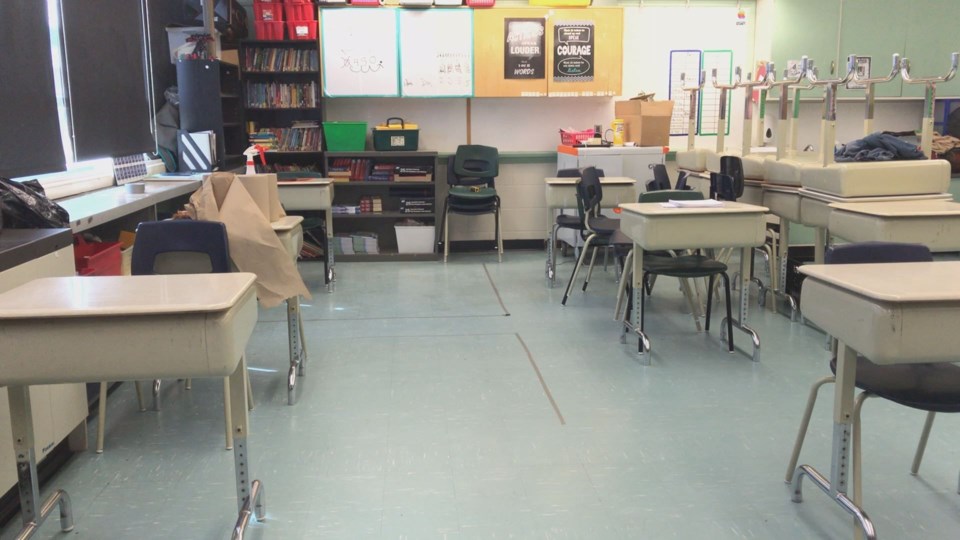TORONTO — Ontario's premier stood by the province's back-to-school plans on Tuesday as federal officials offered up COVID-19-prevention guidelines that appeared to contradict those revealed by provincial officials last week.
Doug Ford's comments came as Ontario's 72 publicly funded school boards worked on firming up their proposals to welcome students back to class. While most of those plans have yet to be finalized, a draft set of guidelines from the country's largest school board suggests sports won't be a part of the upcoming academic year.
The Progressive Conservative government has come under fire since it unveiled its vision for the coming school year last week. The plan will see students in kindergarten through Grade 8 return to school without any reduction in class sizes, though students will spend the day in a single cohort to limit contact with other pupils.
Most high schoolers will also be in class full-time, though students at two dozen boards across the province will take half their courses online in a bid to curb the spread of the novel coronavirus. Masks will be mandatory for those in Grade 4 and up, while those in Grade 3 and below will be encouraged but not required to wear them.
Both federal public health officials and a panel of experts from leading Ontario pediatric hospitals have said physical distancing is a necessary component of any back-to-school plan, but Ford said Tuesday the province's current approach is grounded in science and well-able to protect students and staff alike.
"It's not 'our' plan — we went with some of the brightest minds in the world," Ford said during a news conference in Beamsville, Ont. "They've come up with a plan. I respect their plan. They're the experts. But for the parents who are nervous, I understand."
Ontario parents have not hesitated to voice their concerns in the days since the plan was released last Thursday, saying the crowded classrooms already prevalent across much of the education system will limit the ability to practise physical distancing.
Canada's chief public health officer, Dr. Theresa Tam, also appeared to highlight the importance of preserving personal space at schools during a Tuesday briefing on the national COVID-19 response.
"Arrange your school environment, physically and otherwise, so that physical distancing can happen," Tam said. "Ensure that the number of contacts children and teachers have is minimized."
The expert panel whose advice formed the basis of the Ontario government's plan has encouraged physical distancing whenever possible, though with some variations on the now-familiar public health advice.
Dr. Chuck Hui of the Ottawa-based Children's Hospital of Eastern Ontario previously said a distance of one metre instead of two might be enough among elementary-school students, though two metres is still ideal among older kids.
Other measures contained in the government plan, such as the widespread return to full-time, in-person learning and the use of masks, comply with the guidelines released by CHEO and Toronto's Hospital for Sick Children.
SickKids did not immediately respond to request for comment on the degree of compliance in the province's back-to-school strategy.
Alexandra Adamo, spokeswoman for Education Minister Stephen Lecce, said Ontario's plan was developed with input from "the best medical and scientific leaders in Canada," including SickKids.
"Our single greatest priority is the safety of students, staff, and their families," Adamo said in a statement.
The Ministry of Education, meanwhile, said it is working with school boards to finalize and approve detailed return-to-class plans, noting that task should be completed by the end of the week.
A preliminary version of one such plan from the Toronto District School Board spells out some of the changes coming in September.
High school classes, for instance, will be delivered via so-called "quad-mesters" — four terms consisting of two courses a piece.
The TDSB is one of the provincially designated boards that will be allowing secondary-school students to take half their classes online, with courses taught in-person one week being delivered virtually the next.
The board's plan also states that students will have to do without lockers or school-based sports until further notice.
Dr. Barbara Yaffe, Ontario's associate chief medical officer of health, said the proposal struck her as "reasonable."
"It's not a return to normal — we are still in a pandemic," Yaffe said Tuesday.
This report by The Canadian Press was first published on Aug. 4, 2020.
Michelle McQuigge, The Canadian Press
